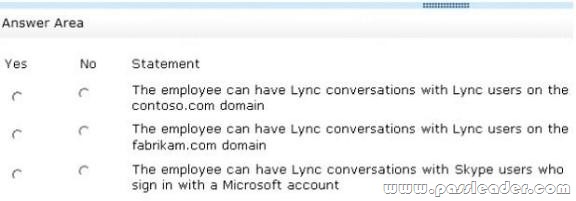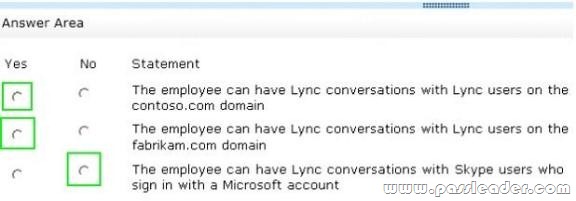Valid 70-347 Dumps shared by PassLeader for Helping Passing 70-347 Exam! PassLeader now offer the newest 70-347 VCE dumps and 70-347 PDF dumps, the PassLeader 70-347 exam questions have been updated and ANSWERS have been corrected, get the newest PassLeader 70-347 dumps with VCE and PDF here: http://www.passleader.com/70-347.html (261 Q&As Dumps –> 307 Q&As Dumps)
BTW, DOWNLOAD part of PassLeader 70-347 dumps from Cloud Storage: https://drive.google.com/open?id=0B-ob6L_QjGLpfjdPREVKSzl1Qk92OExLdVF0RjN1QWZJdWhhbDEycFZKNzZMMUwtQ1pxeFE
QUESTION 37
Hotspot Question
You are the Office 365 administrator for your company’s Microsoft Exchange Online environment. The company recently subscribed to the Office 365 Enterprise E3 plan. Employees currently archive old email messages in .pst files. The company has now mandated that all email messages stored in . pst files must be archived online. You need to enable archiving for all mailboxes. How should you complete the relevant Windows PowerShell script? To answer, select the appropriate cmdlet from each list in the answer area.
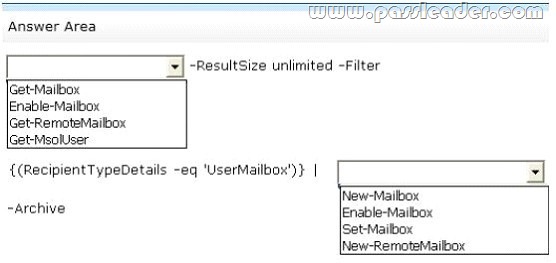
Answer:

Explanation:
In-Place Archiving helps you regain control of your organization’s messaging data by eliminating the need for personal store (.pst) files. With archiving enabled, users can store messages in an archive mailbox, also called an In-Place Archive, which is accessible by using Microsoft Outlook and Outlook Web App. In this question, we use the Get-Mailbox cmdlet to retrieve a list of all mailboxes. The –Filter {(RecipientTypeDetails –eq ‘UserMailbox’)} option is used to retrieve a list of user mailboxes only (thus excluding Room mailboxes, Resource mailboxes etc.). The Enable-Mailbox –Archive command is used to create an archive for each user mailbox returned by the Get-Mailbox command.
https://technet.microsoft.com/en-us/library/jj984357(v=exchg.150)
QUESTION 38
Drag and Drop Question
You are the Office 365 administrator for your company. The company uses Microsoft Lync Online. Due to compliance changes, the company has established the following new requirements:
– All online meeting sessions must include a link to an associated legal disclaimer.
– Every online meeting attendee must be informed that communications might be recorded.
You need to configure the online meeting settings. How should you complete the relevant Windows PowerShell script? To answer, drag the appropriate command segments to the correct targets. Each segment may be used once, more than once, or not at all. You may need to drag the split bar between panes or scroll to view content.

Answer:

Explanation:
The requirements set out in this question are:
1. All online meeting sessions must include a link to an associated legal disclaimer.
2. Every online meeting attendee must be informed that communications might be recorded.
We use:
– The Set-CsMeetingConfiguration cmdlet to modify the meeting (also called conferences) configuration settings for meetings configured in Lync.
– The Set-CsMeetingConfiguration cmdlet without any parameters to filter the list of meetings will modify the settings on all meetings in the organization.
– The LegalURL parameter enables you to provide a URL to a website containing legal information and meeting disclaimers. In this question, the URL is “www.contoso.com/disclaimer.html”. This meets the legal disclaimer requirement set out in the question.
– The CustomFooterText parameter enables you to specify text to be added to the end of custom meeting invitations. In this question, we add the text “This meeting may be recorded” to the invitations to meet the second requirement.
Incorrect Answers:
The New-CsMeetingConfiguration cmdlet creates a new collection of meeting configuration settings at the site or service scope. Meeting configuration settings help dictate the type of meetings that users can create. We need to modify existing meeting settings, not create new ones. Therefore, this answer is incorrect.
https://technet.microsoft.com/en-us/library/gg398648.aspx
QUESTION 39
You are the Office 365 administrator for your company. Many employees work in remote locations with intermittent Internet connectivity. Employees must be able to access and reply to email messages, and access calendars, even when their devices are not connected to the Internet. You need to ensure that employees can access their Microsoft Exchange content offline. What should you do?
A. Configure the Directory Synchronization tool for offline access.
B. Deploy and configure the AppFabric Caching service.
C. Configure the Microsoft SkyDrive Pro Windows Sync client for offline access.
D. Configure Exchange ActiveSync devices.
Answer: D
Explanation:
Exchange ActiveSync is a protocol that enables client devices (smart phones, PDAs, tablets, laptops) to synchronize Exchange mailbox data using HTTP over an Internet connection. All mailbox data including emails, contacts and calendar information is synchronized to the ActiveSync enabled device. A user can compose or reply to emails and configure calendar appointments while the device is not connected to the Internet. When the ActiveSync enabled device connects to the Internet, all changes made to the mailbox data (email replies, calendar events etc.) are synchronized back to the Exchange server.
Incorrect Answers:
A: The Directory Synchronization tool is used in a hybrid configuration of Office 365 and an on-premise Active Directory network. The Directory Synchronization tool is used to synchronize on-premise Active Directory data (user accounts etc.) to the Azure Active Directory. The Directory Synchronization tool is not used for email access. Therefore, this answer is incorrect.
B: Windows Server AppFabric extends Windows Server to provide enhanced hosting, management, and caching capabilities for Web applications and middle-tier services. It is used for the deployment and hosting of applications on Windows Servers. It is not used for email access. Therefore, this answer is incorrect.
C: Microsoft SkyDrive Pro is a cloud storage platform provided by Microsoft. The Microsoft SkyDrive Pro Windows Sync client is used on client computers to synchronize data between the client computer and the SkyDrive cloud storage. It is not used for email access. Therefore, this answer is incorrect.
https://technet.microsoft.com/en-us/library/aa998357%28v=exchg.150%29.aspx
QUESTION 40
Hotspot Question
Your company subscribes to Office 365 Small Business. You need to disable all contact synchronization. Which two service categories should you configure? To answer, select the appropriate service categories in the answer area.
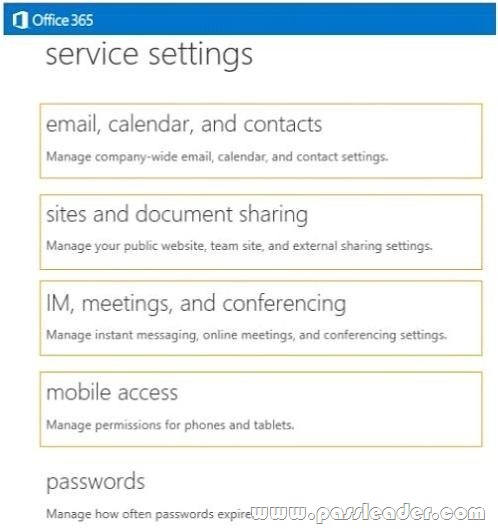
Answer:

Explanation:
– Contact synchronization can be configured in the “email, calendar, and contacts” section.
– Contact synchronization for mobile device can be configured in the “mobile access” section.
QUESTION 41
Hotspot Question
Your company uses Office 365 Small Business. You need to configure the Microsoft Exchange ActiveSync password policy and control the display of presence information. Which two service categories should you configure on the service settings page of the Office 365 admin portal? To answer, select the appropriate service categories in the answer area.

Answer:

Explanation:
Microsoft Exchange ActiveSync is used to enable mobile phone users to access their email, calendar, contacts, and tasks in an Exchange 2013 or Exchange Online environment. Microsoft Exchange ActiveSync password policy is configured in the Mobile Access section in the Office 365 Service Settings page. Presence information in Lync Server enables users to approach colleagues at the right time with the right form of communication, to lead to a more productive work environment. A user’s presence is a collection of information that includes availability, willingness to communicate, additional notes (such as location and status), and how the user can be contacted. Presence is enhanced in Lync Server with pictures, location information, and a rich set of presence states that includes “Off Work,” “Do Not Disturb,” and “Be Right Back,” in addition to basic states such as “Available,” “Busy,” and “In a Conference.” To configure the display of presence information, we need to select the “IM, Meetings and Conferencing” option.
https://technet.microsoft.com/en-us/library/gg417162%28v=ocs.15%29.aspx
QUESTION 42
You are the Office 365 administrator for your company. The company is running Microsoft Exchange Server 2007 with Service Pack 3 on-premises and has 500 mailboxes. Management requests that you migrate all mailboxes to Office 365. You are researching the available migration types. You need to generate a custom step-by-step checklist for multiple migration types. Which tool should you use?
A. Exchange Server Deployment Assistant
B. Exchange Best Practices Analyzer
C. Exchange 2013 Server Role Requirements Calculator
D. Microsoft Remote Connectivity Analyzer
Answer: A
Explanation:
The Exchange Server Deployment Assistant is used to help you configure an Exchange Server deployment. It is a web-based tool that asks you questions about your current environment and then generates a custom step-by-step checklist that will help you deploy Exchange Server for different types of scenarios. The Exchange Server Deployment Assistant asks you questions about your current environment, how many mailboxes you’d like to migrate and which method of migration you’d like to use. You can run the wizard multiple times selecting different options to generate checklists for different migration scenarios.
Incorrect Answers:
B: The Microsoft Exchange Best Practices Analyzer is designed to help you determine the overall health of an existing Exchange server deployment. The tool scans the Exchange servers and topology and identifies items that do not conform to Microsoft best practices. The Exchange Best Practices Analyzer does not generate custom step-by-step checklists for Exchange migrations. Therefore, this answer is incorrect.
C: The Exchange 2013 Server Role Requirements Calculator is a tool used to plan an Exchange server deployment. It is used to help decide how many servers you need and which server roles can be deployed on the same servers or which roles need to be deployed to separate servers. The Exchange 2013 Server Role Requirements Calculator does not generate custom step-by-step checklists for Exchange migrations. Therefore, this answer is incorrect.
D: Microsoft Remote Connectivity Analyzer is a website offered by Microsoft for testing remote connectivity to server services such as Exchange Server, Lync Server and Office 365. Microsoft Remote Connectivity Analyzer does not generate custom step-by-step checklists for Exchange migrations. Therefore, this answer is incorrect.
http://blogs.technet.com/b/blainbar/archive/2014/09/26/part-31-modernizing-your-datacenter-for-hybrid-cloud-migrating-exchange-and-application-servers-to-windows-server-2012-r2.aspx
QUESTION 43
Your company subscribes to the Office 365 Enterprise El plan. You are the Microsoft Exchange Online administrator. In the last week, employees have reported that they are receiving non-delivery report messages from other companies. The employees have not sent messages to recipients within those companies. You need to prevent non-delivery report messages from reaching employees. Which content filter option should you turn on in the Exchange admin center?
A. NDR backscatter
B. Conditional Sender ID filtering: hard fail
C. SPF record: hard fail
D. Block all bulk email messages
Answer: A
Explanation:
NDR backscatter is when spammer forges the user’s email address and sends email on their behalf to other recipients. If the “destination mail system” recognizes the mail as a spam or if the mail is sent to non-existing users, the “destination mail system” creates an NDR message that is sent to the organization recipient (the user whose email address was used by the spammer).
http://blogs.technet.com/b/exchange/archive/2014/08/18/spam-email-and-office-365-environment-connection-and-content-filtering-in-eop.aspx
QUESTION 44
You are the Office 365 administrator for Contoso, Ltd. Some email messages sent from the trusted domain fabrikam.com are being rejected as spam. Some of these email messages originate inside the fabnkam.com network, and some of them originate from an application in the fabrikam.com co-located data center. The fabrikam.com systems administrators have asked you to add their domain and the IP addresses of the data center that hosts their external application to your list of safe senders. You need to configure Microsoft Exchange Online Protection. Which two actions should you perform? Each correct answer presents part of the solution.
A. Configure a content filter to allow the fabrikam.com domain.
B. Configure a mail flow rule to bypass spam filtering for the data center IP address range.
C. Create a connection filter to allow the data center IP address range.
D. Add the fabrikam.com domain as an accepted domain.
E. Create an inbound connector for the fabrikam.com domain.
F. Configure a mail flow rule to bypass spam filtering for the fabrikam.com domain.
Answer: CF
Explanation:
http://blogs.msdn.com/b/tzink/archive/2013/07/02/how-to-use-safe-senders-in-eop-and-fope.aspx
http://www.msexchange.org/kbase/ExchangeServerTips/MicrosoftOffice365/ExchangeOnline/safe-andblocked-senders-list-owa-2013-and-office-365.html
http://technet.microsoft.com/en-GB/library/dn198251(v=exchg.150).aspx
Connection Filters
http://technet.microsoft.com/en-us/library/jj200718(v=exchg.150).aspx
QUESTION 45
Drag and Drop Question
You are an Office 365 specialist for a consulting company. Your company has been hired by several companies to migrate their legacy email solutions to Office 365. You need to recommend mailbox migration strategies for the scenarios described in the following table.

Which strategies should you recommend? To answer, drag the appropriate migration types to the correct targets. Each migration type may be used once, more than once, or not at all. You may need to drag the split bar between panes or scroll to view content.

Answer:

Explanation:
For the Microsoft Exchange Server 2010 mailboxes, we can use a remote move migration. When the mailboxes are moved in the remote move operation, the Mailbox Replication Service is used. This is the same service that is used when moving mailboxes between mailbox servers in an on-premise environment. In this question, the Exchange on-premise and Exchange Online environments will be configured in a hybrid configuration. That will enable us to move mailboxes to Exchange Online in the same way you would move a mailbox to another local mailbox server. A “remote move migration” is used to migrate on-premises Exchange mailboxes to Exchange Online in an Exchange hybrid deployment. You must have an Exchange hybrid deployment to use a remote move migration. With a hybrid deployment, you get the following capabilities:
– User account management in your on-premises organization.
– Directory synchronization between your on-premises and Exchange Online organizations.
– Single sign-on to mailboxes located either on-premises or in the Exchange Online organization.
– Secure mail routing between on-premises and Exchange Online organizations.
– Free/busy and calendar sharing between on-premises and Exchange Online organizations.
For a non-Exchange messaging system, the only migration option available is the IMAP migration. In an IMAP migration, the contents of users’ mailboxes on an IMAP messaging system are migrated to their Exchange Online mailboxes. Here are some requirements and considerations for using an IMAP migration:
– The Exchange Online mailboxes that you migrate email to must already exist. They aren’t provisioned during the IMAP migration process.
– Only items in a user’s inbox or other mail folders are migrated. Contacts, calendar items, or tasks aren’t migrated.
– Small and medium-sized organizations can use an IMAP migration to migrate email from mailboxes on a hosted service provider.
Incorrect Answers:
Cutover migration: In a cutover migration, all mailboxes are moved in a single batch. A cutover migration should be used for less than 2,000 mailboxes. A cutover migration is not supported for non-Exchange mailboxes. Therefore, this answer is incorrect.
Staged migration: A staged migration requires Exchange 2003 or Exchange 2007. It is not supported with Exchange 2010 or non-Exchange mailboxes. Therefore, this answer is incorrect.
https://technet.microsoft.com/en-GB/library/jj863291(v=exchg.150).aspx
QUESTION 46
You are the Microsoft Lync administrator for a company that uses Lync Online. The company has mandated that employees may use Lync Online to communicate with contacts from approved external domains. You need to configure Lync Online to allow Lync federation with only three specific domains. You must achieve this goal by using the least amount of administrative effort. Which two actions should you perform? Each correct answer presents part of the solution.
A. In the Lync admin center, set the External Access option to On except for blocked domains.
B. In the Office 365 admin center, add the three domains to the domain list and set the domain intent for each domain to Lync Online.
C. In the Lync admin center, set the External Access option to Off completely.
D. In the Lync admin center, set the External Access option to On only for allowed domains.
E. In the Lync admin center, configure the Presence Privacy Mode option to display presence information only to the users’ contacts.
F. In the Lync admin center, add the three domains to the Blocked Or Allowed Domains list.
Answer: DF
Explanation:
http://solveit.openjive.com/post/2014/01/27/Lync-Federation-with-Office-365Lync-Online
http://technet.microsoft.com/en-us/library/hh852512.aspx
http://technet.microsoft.com/en-us/library/jj205126.aspx
QUESTION 47
Your company is planning to migrate to Microsoft Exchange Online. The company employs 1,000 people, each with a mailbox currently located on Exchange 2010 on-premises. You estimate that it will take a minimum of four weeks to migrate all mailboxes from on- premises Exchange to Exchange Online. The company has the following migration requirements:
– During the migration, do not change the existing Microsoft Outlook profiles and .ost files used by the employees.
– Ensure that email messages sent between on-premises mailboxes and online mailboxes during the migration are secure.
– Do not send email messages between on-premises mailboxes and online mailboxes over the Internet in plain text.
You need to select the migration strategy that meets the requirements. Which migration strategy should you use?
A. Cutover migration only
B. IMAP migration only
C. Remote move migration only
D. Staged migration only
Answer: C
Explanation:
http://technet.microsoft.com/en-GB/library/jj863291(v=exchg.150).aspx
http://support.microsoft.com/kb/2798131/en-gb
http://technet.microsoft.com/en-GB/library/dn720476(v=exchg.150).aspx
QUESTION 48
Drag and Drop Question
You are the Office 365 administrator for your company. You have been receiving many unsolicited email messages originating from another country. Many of those messages contain foreign-language content. You need to configure Microsoft Exchange Online Protection to filter messages based on the language content and IP addresses of the country or region of origin. Which filters and options should you configure? To answer, drag the appropriate answer choices to the correct targets. Each answer choice may be used once, more than once, or not at all. You may need to drag the split bar between panes or scroll to view content.

Answer:

Explanation:
Content filter settings include selecting the action to take on messages identified as spam, and choosing whether to filter messages written in specific languages, or sent from specific countries or regions. Additionally, you can enable advanced spam filtering options if you want to pursue an aggressive approach to content filtering. Content-filter policy settings are applied to inbound messages only. On the International Spam page you can filter email messages written in specific languages, or sent from specific countries or regions. You can configure up to 86 different languages and 250 different regions. The service will apply the configured action for high confidence spam.
1. Select the Filter email messages written in the following languages check box to enable this functionality. Click “+”, and then in the selection dialog box, make your choices (multi-selection is supported). For example, if you select to filter messages written in Arabic (AR), and Quarantine message is your configured action for high confidence spam messages, then any messages written in Arabic will be quarantined. Click ok to return to the International Spam pane.
2. Select the Filter email messages sent from the following countries or regions check box to enable this functionality. Click “+”, and then in the selection dialog box, make your choices (multi-selection is supported). For example, if you select to filter all messages sent from Australia (AU), and Quarantine message is your configured action for high confidence spam messages, then any messages sent from Australia will be quarantined. Click ok to return to the International Spam pane.
https://technet.microsoft.com/en-us/library/jj200684%28v=exchg.150%29.aspx
QUESTION 49
Hotspot Question
You are the Office 365 administrator for your company. You manage an on-premises Microsoft Exchange Server 2003 environment that has 500 users and an externally-hosted Exchange environment that has 500 users. The hosted Exchange environment does not allow Outlook Anywhere connectivity. You do not have administrative access to all mailboxes in the hosted environment. You plan to migrate and consolidate both environments into Office 365. You have the following migration requirements:
– Migrate on-premises mailboxes in batches by department.
– Migrate email, calendar, and contact items from the on-premises environment.
– Migrate only email from the hosted environment.
In the table below, identify the migration type that must be used for each environment. Make only one selection in each column. Each correct selection is worth one point.

Answer:

Explanation:
For the migration of the on-premise Exchange 2003 mailboxes, we can use a staged migration. In a staged Exchange migration, mailboxes in your on-premises Exchange organization are migrated to Exchange Online in batches. A staged Exchange migration is a good option if your current on-premises email organization and migration goals meet the following conditions:
– You want to permanently move your entire email organization to Office 365.
– You plan to migrate mailboxes to Exchange Online over a few weeks or months.
– You plan to manage user accounts in your on-premises organization and synchronize your on-premises Active Directory with Exchange Online.
– Your current on-premises email organization is Exchange 2003 or Exchange 2007. Staged migration doesn’t support migrating Exchange 2010 or Exchange 2013 mailboxes.
For the migration of the hosted Exchange mailboxes, we can use an IMAP migration. In an IMAP migration, the contents of users’ mailboxes on an IMAP messaging system are migrated to their Exchange Online mailboxes. Here are some requirements and considerations for using an IMAP migration:
– The Exchange Online mailboxes that you migrate email to must already exist. They aren’t provisioned during the IMAP migration process.
– Only items in a user’s inbox or other mail folders are migrated. Contacts, calendar items, or tasks aren’t migrated.
– Small and medium-sized organizations can use an IMAP migration to migrate email from mailboxes on a hosted service provider.
Incorrect Answers:
Remote Move migration: A remote move migration is used for migration Exchange 2013 or Exchange 2010. It cannot be used with Exchange 2003 mailboxes as a hybrid configuration is required. A remote move migration also cannot be used with the hosted Exchange mailboxes because we do not have administrative control of the hosted Exchange mailboxes. Therefore, this answer is incorrect.
Cutover Migration: In a cutover Exchange migration, all mailboxes in your on-premises Exchange organization are migrated to Exchange Online in a single migration batch. We want to migration the on-premise mailboxes in batches. A cutover migration also cannot be used with the hosted Exchange mailboxes because we do not have administrative control of the hosted Exchange mailboxes. Therefore, this answer is incorrect.
http://technet.microsoft.com/en-GB/library/jj863291(v=exchg.150).aspx
QUESTION 50
Hotspot Question
You are the Office 365 administrator for your company’s Microsoft Exchange Online environment. The company recently subscribed to the Office 365 Enterprise El plan. The company wants to filter email messages based on the following criteria:
– Reverse DNS lookup
– Sender open proxy test
– HELO/EHLO analysis
– Analysis of spam confidence level (SCL) ratings on email messages from a specific sender
You need to filter all email messages. How should you complete the relevant Windows PowerShell script? To answer, select the appropriate command segment from each list in the answer area.

Answer:

Explanation:
Sender reputation is part of the Exchange anti-spam functionality that blocks messages according to many characteristics of the sender. Sender reputation relies on persisted data about the sender to determine what action, if any, to take on an inbound message. The Protocol Analysis agent is the underlying agent for sender reputation functionality. A sender reputation level (SRL) is calculated from the following statistics:
– HELO/EHLO analysis – The HELO and EHLO SMTP commands are intended to provide the domain name, such as Contoso.com, or IP address of the sending SMTP server to the receiving SMTP server. Malicious users, or spammers, frequently forge the HELO/EHLO statement.
– Reverse DNS lookup – Sender reputation also verifies that the originating IP address from which the sender transmitted the message matches the registered domain name that the sender submits in the HELO or EHLO SMTP command.
– Analysis of SCL ratings on messages from a particular sender – When the Content Filter agent processes a message, it assigns a spam confidence level (SCL) rating to the message. The SCL rating is a number from 0 through 9. A higher SCL rating indicates that a message is more likely to be spam. Data about each sender and the SCL ratings that their messages yield is persisted for analysis by sender reputation.
– Sender open proxy test – An open proxy is a proxy server that accepts connection requests from anyone anywhere and forwards the traffic as if it originated from the local hosts.
We use the Set-SenderReputationConfig cmdlet to enable filtering based on sender reputation analysis. In this question, it is enabled for both external email and internal email.
https://technet.microsoft.com/en-us/library/bb124512(v=exchg.150).aspx
QUESTION 51
Your company is planning to migrate to Microsoft Exchange Online. The company employs 5,000 people, each with a mailbox currently located on Exchange Server 2000. The company has the following migration requirements:
– Move mailboxes in batches.
– Do not migrate calendar or contact items.
– Provide migration status reports to administrators.
You need to select the appropriate migration strategy. Which migration strategy should you use?
A. Staged migration
B. Cutover migration
C. IMAP migration
D. Hybrid migration
Answer: C
Explanation:
The only migration method supported for Exchange Server 2000 mailboxes is an IMAP migration. In an IMAP migration, the contents of users’ mailboxes on an IMAP messaging system are migrated to their Exchange Online mailboxes. Here are some requirements and considerations for using an IMAP migration:
– The Exchange Online mailboxes that you migrate email to must already exist. They aren’t provisioned during the IMAP migration process.
– Only items in a user’s inbox or other mail folders are migrated. Contacts, calendar items, or tasks aren’t migrated.
– Small and medium-sized organizations can use an IMAP migration to migrate email from mailboxes on a hosted service provider.
Incorrect Answers:
A: A staged migration requires Exchange 2003 or Exchange 2007. It is not supported with Exchange 2000. Therefore, this answer is incorrect.
B: A cutover migration requires Exchange 2003 or later. It is not supported with Exchange 2000. Therefore, this answer is incorrect.
D: A hybrid migration requires Exchange on-premise and Exchange Online to be configured in a hybrid configuration. This is not supported with Exchange 2000. Therefore, this answer is incorrect.
https://technet.microsoft.com/en-GB/library/jj863291(v=exchg.150).aspx
QUESTION 52
You are the Office 365 administrator for your company. The company has established the following new requirements:
– Members of the legal team must be able to conduct eDiscovery searches.
– Employees must be notified when they send email messages that contain confidential information.
You need to configure the environment. Which two actions should you perform? Each correct answer presents part of the solution.
A. Configure journaling to a Microsoft Exchange Online mailbox for all mailboxes.
B. Add the members of the legal team to the Discovery Management role group.
C. Create a Data Loss Prevention policy.
D. Place all executive mailboxes on In-Place Hold for 365 days and use In-Place eDiscovery for mailbox searches.
E. Enable Microsoft Exchange Online Archiving for the executive mailboxes.
F. Place all executive mailboxes on Retention Hold.
Answer: BC
Explanation:
To enable members of the legal team to conduct eDiscovery searches, we need to add them to the Discovery Management role group. Members of the Discovery Management role group can access sensitive message content. Specifically, these members can use In-Place eDiscovery to search all mailboxes in your Exchange organization, preview messages (and other mailbox items), copy them to a Discovery mailbox and export the copied messages to a .pst file. In most organizations, this permission is granted to legal, compliance, or Human Resources personnel. To ensure that employees are notified when they send email messages that contain confidential information, we need to configure a Data Loss Prevention (DLP) policy. A Data Loss Prevention (DLP) policy is a set of conditions that define what is regarded as sensitive or confidential information. This new DLP feature performs deep content analysis through keyword matches, dictionary matches, regular expression evaluation, and other content examination to detect content that violates organizational DLP policies. In addition to the customizable DLP policies themselves, you can also inform email senders that they may be about to violate one of your policies—even before they send an offending message. You can accomplish this by configuring Policy Tips. Policy Tips are similar to MailTips, and can be configured to present a brief note in the Microsoft Outlook 2013 client that provides information about possible policy violations to a person creating a message.
Incorrect Answers:
A: Journaling lets you record a copy of, or journal, all email communications in your organization and send them to a dedicated mailbox on an Exchange Server. It is not used to ensure that employees are notified when they send email messages that contain confidential information. Therefore, this answer is incorrect.
D: There is no need to place all executive mailboxes on In-Place Hold for 365 days and use In-Place eDiscovery for mailbox searches. Members of the legal team must be able to conduct eDiscovery searches on all mailboxes. They can do this when they have the appropriate permissions. Therefore, this answer is incorrect.
E: Microsoft Exchange Online Archiving is not required to enable eDiscovery searches. We just need to assign the appropriate permissions to the legal team (by way of Discovery Management role group membership). Therefore, this answer is incorrect.
F: A retention hold is used to halt retention policy, which means the Managed Folder Assistant (MFA) does not move or delete items from the mailbox. A retention hold is not required to enable eDiscovery searches. We just need to assign the appropriate permissions to the legal team (by way of Discovery Management role group membership). Therefore, this answer is incorrect.
https://technet.microsoft.com/en-GB/library/dd298059%28v=exchg.150%29.aspx
https://technet.microsoft.com/en-us/library/jj150527%28v=exchg.150%29.aspx
QUESTION 53
Hotspot Question
Your company has an Office 365 subscription and uses Microsoft Lync Online. The environment includes the domains shown in the following image, and is configured as shown in the exhibit. (Click the Exhibit button.)


Lync is not deployed in a hybrid configuration. An employee requires specific Lync communication settings. The employee’s account is configured as shown in the following image. For each of the following statements, select Yes if the statement is true. Otherwise, select No. Each correct selection is worth one point.
QUESTION 54
Hotspot Question
You are the Office 365 administrator for your company. Management has requested a report of all Microsoft Exchange ActiveSync-enabled employees and their devices. You need to generate a report that contains employee display names and device types. How should you complete the relevant Windows PowerShell script? To answer, select the appropriate option from each list in the answer area.
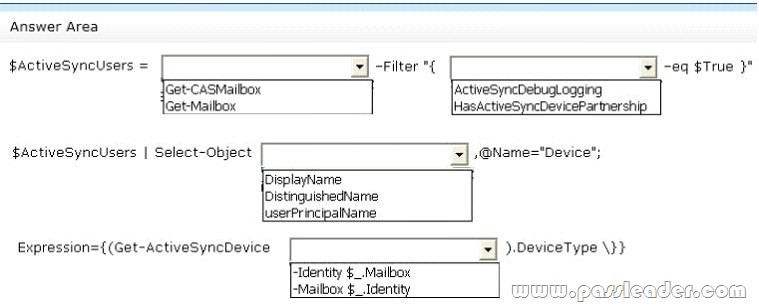
Answer:
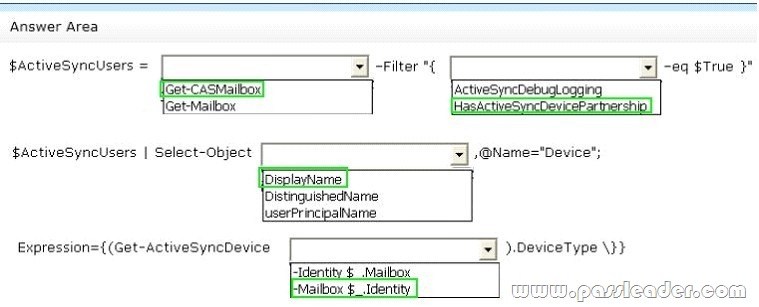
Explanation:
We use the Get-CASMailbox cmdlet to view the client access settings that are configured on a mailbox. The setting we are interested in is HasActiveSyncDevicePartnership. This will return a list of all mailboxes that are configured for ActiveSync and store the results in the $ActiveSyncUsers variable. We use the Select-Object cmdlet with the Displayname option to display the employee display names from the mailboxes. The “Expression={(Get-ActiveSyncDevice –Mailbox $_.Identity).DeviceType \)}” expression is used to return a list of Device Types.
https://technet.microsoft.com/en-us/library/bb124754%28v=exchg.150%29.aspx
https://technet.microsoft.com/en-us/library/hh849895.aspx
Get the newest PassLeader 70-347 VCE dumps here: http://www.passleader.com/70-347.html (261 Q&As Dumps –> 307 Q&As Dumps)
And, DOWNLOAD the newest PassLeader 70-347 PDF dumps from Cloud Storage for free: https://drive.google.com/open?id=0B-ob6L_QjGLpfjdPREVKSzl1Qk92OExLdVF0RjN1QWZJdWhhbDEycFZKNzZMMUwtQ1pxeFE

